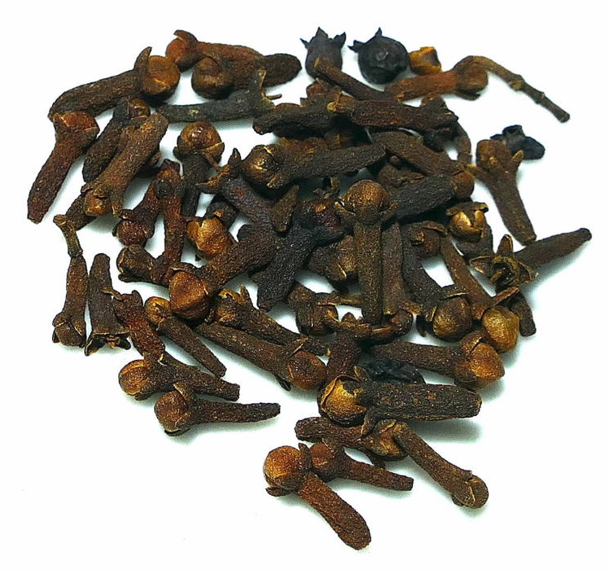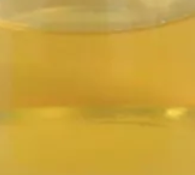| "Descrizione" by A_Partyns (12948 pt) | 2022-Nov-26 09:59 |
Review Consensus: 10 Rating: 10 Number of users: 1
| Evaluation | N. Experts | Evaluation | N. Experts |
|---|---|---|---|
| 1 | 6 | ||
| 2 | 7 | ||
| 3 | 8 | ||
| 4 | 9 | ||
| 5 | 10 |
Eugenol (1-allyl-4-hydroxy-3-methoxybenzene) is a phenolic compound that occurs naturally in many plants, including Melaleuca bracteata, or black tea plant, in basil, nutmeg, cloves, fish such as carp, catfish, shrimp and turbot (1) and is also found in honey (2).

Industrially, Eugenol is found as a powder or as an essential oil.
In its solid state, Eugenol appears as a white or brown powder.

In its liquid state, Eugenol appears as a yellowish, stable liquid. Flammable. Incompatible with strong oxidising agents.

What it is used for and where
Medical
It is one of the most important active components of cloves along with isoeugenol. Eugenol is a very interesting component from a clinical point of view due to its potential role in preventing and alleviating chronic diseases such as inflammation and cancer. It has demonstrated anti-inflammatory and radical-scavenging activity (protects cells from damage that free radicals, unstable molecules, produce in the human body) with potential to modulate chronic diseases (3). Furthermore, Eugenol, through its multiple antioxidant activities, which include dimerisation (union of two molecules into a double molecule called a dimer) and chelating effect (protection from undesirable agents), can be considered effective in combating chronic diseases.
It possesses antimicrobial activity (4), is a potential therapeutic strategy against temporal lobe epilepsy (5) and, with its anti-inflammatory activity, is a promising bioactive molecule for improving contact dermatitis.
In endodontic treatment, it, together with other components, inhibited periapical abscess and improved pathological bone resorption (6).
Food
Fragrance and preservative to perfume products containing it with clove and cinnamon (from which it is extracted). In the food industry, Eugenol, together with sodium caseinate, demonstrated extraordinary stability during environmental storage (22 °C) for up to 30 days and maintained good redispersibility after spray drying or freezing (7).
Cosmetics
Eugenol is a popular fragrance in cosmetics and is used to perfume products containing it with clove and cinnamon (from which it is extracted).
Safety
It is a substance that can give allergy so its name must be mandatorily written on the component label, but it is considered acceptable with a MOE (Margin of Exposure) of less than 100 (8).
The most relevant studies on the subject have been selected with a summary of their contents:
Typical characteristics of the commercial product Eugenol in oil form
| Appearance | Yellowish liquid |
| Boiling Point | 255.0±0.0°C at 760 mmHg |
| Melting Point | −12-−10 °C(lit.) |
| Flash Point | 119.8±8.1°C |
| Density | 1.1±0.1 g/cm3 |
| Refraction Index | 1.536 |
| Vapor Pressure | 0.0±0.5 mmHg at 25°C |
| PSA | 29.46000 |
| LogP | 2.20 |
| Chemical Safety |  |
 |  |
 |  |
- Molecular Formula C10H12O2
- Linear Formula 4-(H2C=CHCH2)C6H3-2-(OCH3)OH
- Molecular Weight 164.204 g/mol
- Exact Masss 164.083725
- UNII 3T8H1794QW
- CAS 97-53-0
- EC Number: 202-589-1
- DSSTox Substance ID DTXSID9020617
- IUPAC 2-methoxy-4-prop-2-enylphenol
- InChl=1S/C10H12O2/c1-3-4-8-5-6-9(11)10(7-8)12-2/h3,5-7,11H,1,4H2,2H3
- InChl Key RRAFCDWBNXTKKO-UHFFFAOYSA-N
- SMILES COC1=C(C=CC(=C1)CC=C)O
- FEMA Number: 2467
- PubChem Substance ID 24894609
- MDL number MFCD00008654
- Beilstein Registry Number 1366759
- NSC 8895 209525 757030
- JECFA 1529
Synonyms:
- 4-Allyl-2-methoxyphenol
- 4-Allylguaiacol
- Eugenic acid
- Allylguaiacol
- Caryophyllic acid
- p-Allylguaiacol
- 2-methoxy-4-(prop-2-en-1-yl)phenol
- Eugenol (natural)
- 4-Hydroxy-3-methoxy-1-allylbenzene
- 2-Hydroxy-5-allylanisole
- 4-Hydroxy-3-methoxyallylbenzene
- Phenol, 4-allyl-2-methoxy-
- 2-Methoxy-4-(2-propen-1-yl)phenol
- Eugenol [USAN]
- NCI-C50453
- 4-Allylcatechol 2-methyl ether
- 1-allyl-4-hydroxy-3-methoxybenzene
- 1-Allyl-3-methoxy-4-hydroxybenzene
- 2-Metoksy-4-allilofenol
- p-Eugenol
- 2-Methoxy-4-prop-2-enylphenol
- Engenol
- 2-Methoxy-4-allylphenol
- 2-Methoxy-4-(2-propenyl)phenol
- Phenol, 2-methoxy-4-(2-propenyl)-
- 1,3,4-Eugenol
- 4-Allylcatechol-2-methyl ether
- Synthetic eugenol
- 1-Hydroxy-2-methoxy-4-allylbenzene
- 2-Methoxy-1-hydroxy-4-allylbenzene
- 4-Allyl-1-hydroxy-2-methoxybenzene
- 5-Allylguaiacol
- 1-Hydroxy-2-methoxy-4-prop-2-enylbenzene
References____________________________________________________________________
(1) Li J, Liu H, Wang C, Wu L, Liu D. Determination of eugenol in fish and shrimp muscle tissue by stable isotope dilution assay and solid-phase extraction coupled gas chromatography-triple quadrupole mass spectrometry. Anal Bioanal Chem. 2016 Sep;408(24):6537-44. doi: 10.1007/s00216-016-9850-z.
(2) Tonello N, Moressi MB, Robledo SN, D'Eramo F, Marioli JM. Square wave voltammetry with multivariate calibration tools for determination of eugenol, carvacrol and thymol in honey. Talanta. 2016 Sep 1;158:306-314. doi: 10.1016/j.talanta.2016.05.071.
(3) Fujisawa S, Murakami Y. Eugenol and Its Role in Chronic Diseases. Adv Exp Med Biol. 2016;929:45-66. doi: 10.1007/978-3-319-41342-6_3.
(4) Manrique Y, Gibis M, Schmidt H, Weiss J. Antimicrobial efficacy of sequentially applied eugenol against food spoilage micro-organisms. J Appl Microbiol. 2016 Dec;121(6):1699-1709. doi: 10.1111/jam.13294.
(5) Kim SR. Control of Granule Cell Dispersion by Natural Materials Such as Eugenol and Naringin: A Potential Therapeutic Strategy Against Temporal Lobe Epilepsy. J Med Food. 2016 Aug;19(8):730-6. doi: 10.1089/jmf.2016.3712.
Abstract. The hippocampus is an important brain area where abnormal morphological characteristics are often observed in patients with temporal lobe epilepsy (TLE), typically showing the loss of the principal neurons in the CA1 and CA3 areas of the hippocampus. TLE is frequently associated with widening of the granule cell layer of the dentate gyrus (DG), termed granule cell dispersion (GCD), in the hippocampus, suggesting that the control of GCD with protection of hippocampal neurons may be useful for preventing and inhibiting epileptic seizures. We previously reported that eugenol (EUG), which is an essential component of medicinal herbs and has anticonvulsant activity, is beneficial for treating epilepsy through its ability to inhibit GCD via suppression of mammalian target of rapamycin complex 1 (mTORC1) activation in the hippocampal DG in a kainic acid (KA)-treated mouse model of epilepsy in vivo. In addition, we reported that naringin, a bioflavonoid in citrus fruits, could exert beneficial effects, such as antiautophagic stress and antineuroinflammation, in the KA mouse model of epilepsy, even though it was unclear whether naringin might also attenuate the seizure-induced morphological changes of GCD in the DG. Similar to the effects of EUG, we recently observed that naringin treatment significantly reduced KA-induced GCD and mTORC1 activation, which are both involved in epileptic seizures, in the hippocampus of mouse brain. Therefore, these observations suggest that the utilization of natural materials, which have beneficial properties such as inhibition of GCD formation and protection of hippocampal neurons, may be useful in developing a novel therapeutic agent against TLE.
(6) de Deus Moura Lde F, de Lima Mde D, Lima CC, Machado JI, de Moura MS, de Carvalho PV. Endodontic Treatment of Primary Molars with Antibiotic Paste: A Report of 38 Cases. J Clin Pediatr Dent. 2016;40(3):175-7. doi: 10.17796/1053-4628-40.3.175.
Abstract. Objective: This study presents 38 cases of primary molars with necrotic pulps treated with antibiotics-based paste. Case report: The technique consisted of necrotic tissue removal of the pulp chamber, using spoons excavators and low speed drills. Pulp cavity was washed with saline solution and dried with sterile cotton balls. Then an antibiotic paste composed of chloramphenicol, tetracycline, zinc oxide and eugenol - CTZ paste - was inserted at the entrance of root canals. Patients were evaluated clinically and radiographically at different times. The criteria that defined clinical success were the lack of periapical abscess and mobility compatible with chronological age. Radiographic assessments consisted in absence of radiolucency in the region of root bifurcation and pathological bone resorption. Conclusion: There were 100% and 93% of clinical and radiographic success, respectively. The results suggest that the CTZ paste is an optional therapy for pulp of primary molars.
(7) Wang L, Zhang Y. Eugenol Nanoemulsion Stabilized with Zein and Sodium Caseinate by Self-Assembly. J Agric Food Chem. 2017 Apr 12;65(14):2990-2998. doi: 10.1021/acs.jafc.7b00194.
(8) Api AM, Belsito D, Bhatia S, Bruze M, Calow P, Dagli ML, Dekant W, Fryer AD, Kromidas L, La Cava S, Lalko JF, Lapczynski A, Liebler DC, Miyachi Y, Politano VT, Ritacco G, Salvito D, Schultz TW, Shen J, Sipes IG, Wall B, Wilcox DK. RIFM fragrance ingredient safety assessment, Eugenol, CAS Registry Number 97-53-0. Food Chem Toxicol. 2016 Nov;97S:S25-S37. doi: 10.1016/j.fct.2015.12.013.
| Evaluate |

